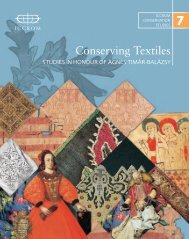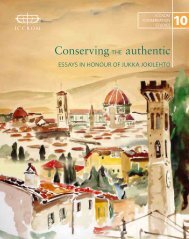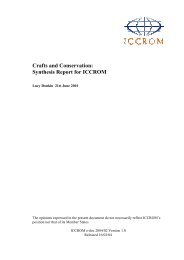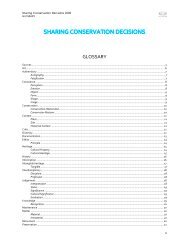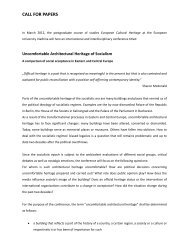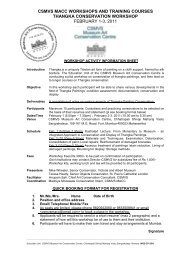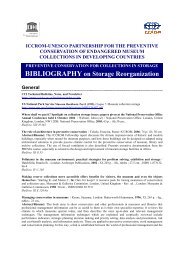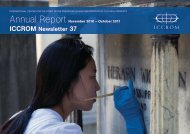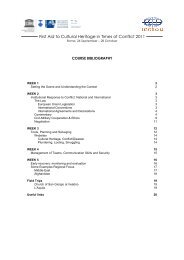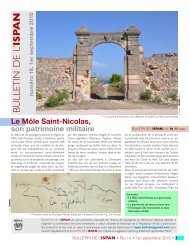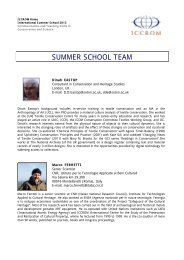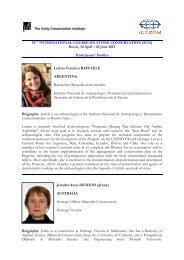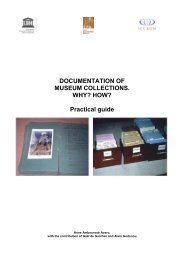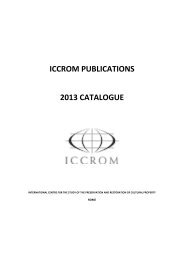part 1 - Iccrom
part 1 - Iccrom
part 1 - Iccrom
Create successful ePaper yourself
Turn your PDF publications into a flip-book with our unique Google optimized e-Paper software.
MEASURING HERITAGE CONSERVATION PERFORMANCE<br />
6th International Seminar on Urban Conservation<br />
of buildings and sites with cultural and natural values<br />
(UNESCO 1972), objects, landscapes and places<br />
of cultural significance (ICOMOS Australia, 1999),<br />
as well as living and intangible heritage (UNESCO<br />
2003). Although this paper focuses on material (or<br />
tangible) cultural heritage, its principles could<br />
be used in the future to assess intangible cultural<br />
expressions.<br />
2. Further aims of conservation practice<br />
Perhaps the most widely accepted ideas about the<br />
aims of conservation are those established by the<br />
Burra Charter and the UNESCO Conventions, which<br />
consider that the primary aim of the profession is the<br />
conservation of cultural significance and the values<br />
that are entailed in cultural heritage. In this sense, it<br />
is widely accepted that the primary aim of conservation<br />
practice is to preserve the values attributed to<br />
heritage and those aspects that give significance to<br />
objects, buildings, sites, landscapes and traditions.<br />
In recent years, however, professionals have questioned<br />
the role that conservation of cultural heritage<br />
must play in societies. Research carried out by<br />
the Getty Conservation Institute (2000, p. 3), for<br />
instance, has stressed that heritage conservation is<br />
“an integral <strong>part</strong> of civil society”, and that conservation<br />
can no longer be an isolated profession with its<br />
own distinctive aims, but should reach out to people<br />
and have a positive impact on society, including<br />
social and economic benefits. British heritage professionals<br />
and institutions have also emphasized the<br />
role that conservation has in public life, arguing that<br />
a further aim of conservation is to have an impact<br />
on the social and economic realms of society (Jones<br />
and Holden, 2008). That is to say, there is a clear tendency<br />
of heritage conservation of shifting attention<br />
from cultural heritage to the social agents that confer<br />
cultural values to heritage.<br />
Some recent trends have also gone further and considered<br />
not only the values placed on cultural heritage<br />
and the people involved with it, but also the<br />
environmental impacts generated by conservation<br />
practice. This is the case of National Trust, United<br />
Kingdom’s non-governmental body in charge of<br />
protecting the country’s heritage, which has proposed<br />
the Triple Bottom Line Tool. This approach<br />
draws on sustainability principles and considers<br />
the impact that conservation practice has on people,<br />
finance and environment (Lithgow and Thackray,<br />
2009). However, it is worth noting that the environmental<br />
aspect should not only be seen as something<br />
to which negative impacts should be minimized, but<br />
it should be regarded as an asset that could also be<br />
enhanced, given the fact that cultural and natural<br />
values are often closely linked, and natural values<br />
are also worthy of conservation, enhancement and<br />
responsible management.<br />
Based on the outlined principles, an assessment<br />
of conservation activities should consider the preservation<br />
of cultural significance as well as a clear<br />
understanding of the positive and negative social,<br />
economic and environmental impacts that such<br />
activities may bring about.<br />
3. Assessing the performance<br />
of conservation<br />
In the field of culture and cultural heritage conservation,<br />
it has been recognized that indicators need<br />
to develop further since otherwise it is impossible<br />
to evaluate the success of related programs. After a<br />
thorough analysis of the world’s situation of culture<br />
and development, the World Commission on Culture<br />
and Development (1996, pp. 44-53) highlighted<br />
the relevance of developing indicators in order to<br />
obtain a finer picture of specific situations.<br />
In the field of environmental conservation, an indicator<br />
is defined as “a quantitative or qualitative factor<br />
or variable that provides a simple and reliable<br />
means to measure how well a desired outcome, value<br />
or criterion has been achieved or fulfilled” (Schreckenberg<br />
et al. 2010, p. 29). Indicators are therefore useful<br />
for evaluating long-term trends, and informing<br />
on planning and policy-making.<br />
Indicators are also useful to encourage public<br />
involvement if they are used with a stakeholder<br />
approach. In this way, indicators can be used as reliable<br />
data to address the interested public before the<br />
reformulation of policies (see Figure 1).<br />
Regarding the characteristics of indicators, it has<br />
been emphasized that they should be both conceptually-based<br />
and simplified in order to be practical<br />
(Hubbard, 2009). It is also worth noticing that<br />
indicators should always be dictated by the aims<br />
of conservation and by the values linked to cultural<br />
heritage that we are trying to protect. In this sense<br />
it is important to bear in mind that the cultural significance<br />
of each place or site is constantly being<br />
reformulated due to the changing nature of values<br />
(see Zancheti et al., 2009). This implies that indicators<br />
need to be constantly reformulated in order to<br />
account for the change in cultural significance and<br />
the consequent change in the aims of conservation.<br />
Therefore, conservation activities should not try to<br />
Alonso, V. I. & V. M. Meurs. 2012. Assessing the performance of conservation activities. In Zancheti, S. M. & K. Similä, eds. Measuring<br />
heritage conservation performance, pp. 1-14. Rome, ICCROM.<br />
2



